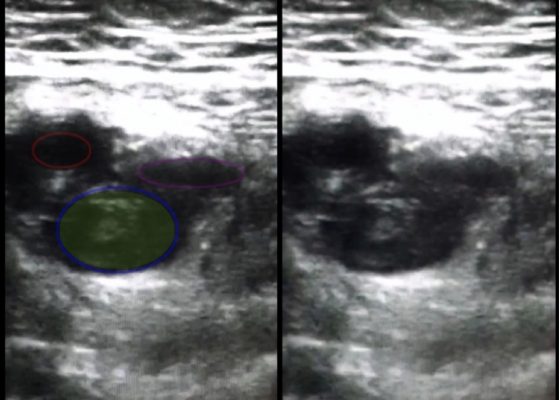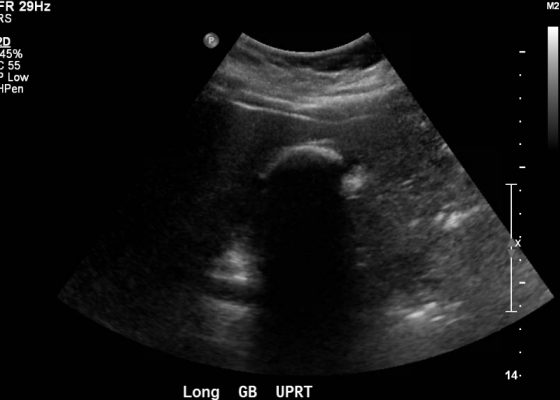Ultrasound
Use of Bedside Compression Ultrasonography for Diagnosis of Deep Venous Thrombosis
DOI: https://doi.org/10.21980/J81G94As shown in the still image of the performed ultrasound, a transverse view of the proximal-thigh revealed a visible thrombus (green shading) occluding the lumen of the left common femoral vein (blue ring), which was non-compressible when direct pressure was applied to the probe. Also visible is a patent and compressible branch of the common femoral vein (purple ring) and the femoral artery (red ring), highlighted by its thick vessel wall and pulsatile motion.
Emed-Opoly: Echocardiography
DOI: https://doi.org/10.21980/J8PC77By the end of this session, the learner will be able to:
1) Recognize normal and abnormal left heart global function
2) Recognize normal and abnormal right heart global function
3) Recognize pericardial effusions and pericardial tamponade
A Toddler with Abdominal Pain and Emesis
DOI: https://doi.org/10.21980/J8XW2PIn the long axis video, the appendix appears as an enlarged, non-compressible, blind-ending tubular structure (white arrow) with distinct appendiceal wall layers and lack of peristalsis. In the short axis video, the appendix appears as a target sign (yellow arrow) between the abdominal and psoas muscles. The maximal outer diameter (MOD) measures 11.8mm and the appendix wall measures 0.17mm. There is trace adjacent free fluid and echogenic periappendiceal fat. Transverse axis video and image (red arrow) demonstrate that the appendix is not compressible. These findings are consistent with acute appendicitis.
Advanced Ultrasound Workshops for Emergency Medicine Residents
DOI: https://doi.org/10.21980/J8W88FThis curriculum seeks to renew interest in ultrasound by presenting two advanced workshops on nontraditional content. Sessions covered ways ultrasound could augment or replace aspects of the physical exam, and covered ultrasound guided nerve blocks
Bedside Echocardiography for Rapid Diagnosis of Malignant Cardiac Tamponade
DOI: https://doi.org/10.21980/J82S38The video shows a subxiphoid view of the heart with evidence of a large pericardial effusion with tamponade – note the anechoic stripe in the pericardial sac (see red arrow). This video demonstrates paradoxical right ventricular collapse during diastole and right atrial collapse during systole which is indicative of tamponade.1,2
Figure 1 is from the same patient and shows sonographic pulsus paradoxus. This is an apical 4 chamber view of the heart with the sampling gate of the pulsed wave doppler placed over the mitral valve. The Vpeak max and Vpeak min are indicated. If there is more than a 25% difference with inspiration between these 2 values, this is highly suggestive of tamponade.1 In this case, there is a 32.4% difference between the Vpeak max 69.55 cm/s and Vpeak min 46.99 cm/s.
Cholelithiasis: WES Sign
DOI: https://doi.org/10.21980/J8X300Abdominal ultrasound showed the classic presentation of the Wall-Echo-Shadow (WES) sign. The superficial aspect of the gallbladder wall is represented by a hyperechogenic curve. Below this, bile fluid is represented by hypoechogenicity. Underneath the bile fluid is the echo of the dense border created by the collection of gallstones, represented by a hyperechogenic curve. Due to the high density of the gallstones, nothing deeper can be visualized (including other gallstones or the far end of the gallbladder); this is the shadow.
A Formalized Three-Year Emergency Medicine Residency Ultrasound Education Curriculum
DOI: https://doi.org/10.21980/J8RG6HLearners will 1) know the indications for each the 11 ACEP point-of-care ultrasound (POCUS) applications; 2) perform each of the 11 ACEP POCUS applications; 3) integrate POCUS into medical decision-making.
Atrial Myxoma
DOI: https://doi.org/10.21980/J87P45Bedside ultrasound revealed the presence of a left atrial mass that appeared to be tethered to the mitral valve. The mass was best viewed on ultrasound in the apical four-chamber window with the phased array probe placed over the patients’ point of maximal impact (PMI), with the patient in left lateral decubitus position.
Left Ventricular Assist Device (LVAD) Cardiac Ultrasound
Keywords: LVAD, left ventricular assist device, ultrasound, TTE, transthoracic ultrasound Image credit: Drs. Madison Nashu and Megan Guy





